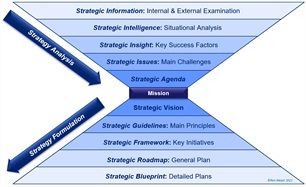Strategy Hourglass
Which steps do I need to take to come up with a strategy? TIAS professor of Strategic Leadership Ron Meyer presents an insightful tool to kickstart your thinking: Strategy Hourglass.
Key Definitions
Strategy is the course of action pursued by an organization to realize its mission. To achieve a sensible pattern of action, organizations generally reflect on the situation they are in (strategy analysis) and then determine a plan of action they want to follow (strategy formulation).
Engaging in strategy analysis and formulation can be time and energy consuming, while also slowing down decision-making. Therefore, strategists always need to consider which strategy-making steps are essential and where the strategy process can be more streamlined.
Conceptual Model
The Strategy Hourglass outlines all ten steps that organizations might potentially want to go through to come up with a detailed strategic plan. There are five analysis steps and then passing through the filter of the mission there are five formulation steps. The metaphor of the hourglass is intended to convey the amount of time that will pass if all ten steps are part of the process, with the steps at the very top and bottom taking long, while those near the middle can be done more quickly. The underlying message is to keep the strategy process as lean as possible by focusing on the center and not getting lost in the periphery.

Download picture
The ten steps of strategy-making are the following:
- Strategic Information. The first step is to widely collect information on all developments inside and outside the organization. This information can be readily available from internal and external sources but can also involve doing active research.
- Strategic Intelligence. The second step is to interpret this strategic information, to draw conclusions about the situation the organization is in. Strategists will want to understand what should be seen as opportunity or threat, and what as strength or weakness.
- Strategic Insight. The third step is to infer how the opportunities, threats, strengths, and weaknesses interact with one another to shape the rules of the competitive game and to weigh what might have the highest impact on success or failure.
- Strategic Issues. Once the key success factors are clear, the fourth step is to deduce which challenging topics need to be dealt with, either because they present a danger to success or because they present a route to achieve success.
- Strategic Agenda. As not all issues can be addressed at the same time, the fifth step is to prioritize the key issues and to focus the attention of the strategists on formulating a strategic answer to this shortlist of topics.
- Strategic Vision. The sixth step is to formulate a big picture answer to the issues on the strategic agenda, within the context of the mission. This rough sketch of a long-term solution will be short in details, but needs to be coherent, attractive, and attainable.
- Strategic Guidelines. With a strategic vision determining the overall direction, the seventh step is to formulate some general principles that will guide to organization to get to the vision. These are the main pillars or routes to achieve the vision.
- Strategic Framework. The eighth step is to outline the major initiatives that will form the steppingstones along each of the routes to the vision. Together these steppingstones (or building blocks) represent a consistent framework for realizing the vision.
- Strategic Roadmap. The ninth step is work out each initiative (or project) into more detail, determining the major activities, general milestones, main responsibilities, and required budgets. This is about broad-stroke planning.
- Strategic Blueprint. The final step is to translate each of the strategic roadmaps into comprehensive plans detailing all activities, timings, responsibilities, and resources. Blueprints need to be SMART (specific, measurable, actionable, realistic, and time-bound).
Key Insights
- Strategy-making involves analysis and formulation. Anyone making a strategy needs to go through the steps of analysis and formulation, although not necessarily in the simple linear order presented here (see model 13, Strategy Development Cycle, as alternative).
- Strategy analysis is about condensing. The main challenge of strategy analysis is to avoid drowning in the sheer endless amount of internal and external information and to consolidate it into an increasingly more valuable understanding of the situation. Each step in the analysis process is about condensing and enriching information.
- Strategy formulation is about expanding. The main challenge of strategy formulation is to avoid coming up with a long list of incoherent initiatives. It is important to start with a strategic vision that is internally consistent and answers the strategic agenda. Each step in the formulation process is then about expanding and detailing these core ideas.
- Time investment differs per step. The first two and the last two steps require an exponentially higher amount of time and energy to complete than all others, significantly slowing down strategy-making and testing the patience of everyone involved.
- Strategy-making can be leaner. Starting with the strategic issues or even the strategic agenda can speed up the process. Time can also be saved by not working out all initiatives into roadmaps or blueprints. Smart strategists seek ways to pragmatically cut corners.
Inspired by this kickstart?
The six-day Masterclass Strategic Leadership will teach you how to make well-informed strategic decisions and effectively manage the organization developing its vision. This will help you grow as a strategic thinker and leader. During this masterclass, you will work on solutions for a problem that you bring in from personal experience. In addition, you will reflect on the functioning of your management team and organization and thus help your organization to grow effectively.
Read more »
Strategy Hourglass is part 28 of a series of management models by prof. dr. Ron Meyer. Ron is managing director of the Center for Strategy & Leadership and publishes regularly on Center for Strategy & Leadership